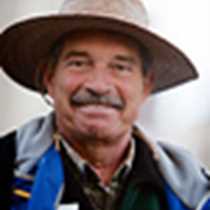Desolation Sound, British Columbia
Under low fog, gray skies and a perfectly flat ocean we covered the last few miles across the Strait of Georgia to Desolation Sound, off the mainland of British Columbia. During breakfast we slowly entered an arm of the sound called Malaspina Strait and then into Grace Harbour. Oyster and mussel farms occur here. We landed at the entrance to Desolation Sound Provincial Park, an extensive archipelago of glaciated islands now clothed in Douglas firs, grand firs and red-barked arbutus trees. The longer walking group set off toward a hidden lake, while the more relaxed wandered slowly through a forest that has now regenerated after being logged perhaps 50 years ago.
The forest here was more humid than that on Stuart Island two days ago. Plant diversity was much higher, especially in the understorey. While the first group made it to the lake, the second group was content to find a small, gurgling waterfall emptying into the salt water. Here they discovered an old and rusting wreck of a Caterpillar bulldozer or donkey engine, which had worked very hard for many years, either building roads or dragging logs to a landing, as fallers downed the massive, old-growth trees. Huge, decomposing stumps still remain, some with telltale notches cut by the fallers, into which they hinged their springboards. On these flexible perches, the fallers could gain height and thereby cut above the flared base and root stocks, to save energy and time. A few edible plants were found along the way, including non-native crabapples and blackberries, and native salal berries.
By mid afternoon we had moved National Geographic Sea Lion and anchored at a lovely spot among the William Islands. We kayaked and Zodiac cruised along the rocky shoreline in search of interesting flora and fauna. Some of us saw a mink foraging at the tide line, and all of us saw the abundant purple seastars, feeding within the enormous beds of oysters. We chose not to emulate the seastars, as the area is known for occasional red tides, a bloom of microscopic marine organisms which, when concentrated in certain shellfish, can cause PSP or paralytic shellfish poisoning to those who eat the shellfish!
It was here, also, that we saw exposed rocks hosting good numbers of socializing harbor seals. The weather forecast had been for rain today, but we experienced a perfect rain-free day!
Under low fog, gray skies and a perfectly flat ocean we covered the last few miles across the Strait of Georgia to Desolation Sound, off the mainland of British Columbia. During breakfast we slowly entered an arm of the sound called Malaspina Strait and then into Grace Harbour. Oyster and mussel farms occur here. We landed at the entrance to Desolation Sound Provincial Park, an extensive archipelago of glaciated islands now clothed in Douglas firs, grand firs and red-barked arbutus trees. The longer walking group set off toward a hidden lake, while the more relaxed wandered slowly through a forest that has now regenerated after being logged perhaps 50 years ago.
The forest here was more humid than that on Stuart Island two days ago. Plant diversity was much higher, especially in the understorey. While the first group made it to the lake, the second group was content to find a small, gurgling waterfall emptying into the salt water. Here they discovered an old and rusting wreck of a Caterpillar bulldozer or donkey engine, which had worked very hard for many years, either building roads or dragging logs to a landing, as fallers downed the massive, old-growth trees. Huge, decomposing stumps still remain, some with telltale notches cut by the fallers, into which they hinged their springboards. On these flexible perches, the fallers could gain height and thereby cut above the flared base and root stocks, to save energy and time. A few edible plants were found along the way, including non-native crabapples and blackberries, and native salal berries.
By mid afternoon we had moved National Geographic Sea Lion and anchored at a lovely spot among the William Islands. We kayaked and Zodiac cruised along the rocky shoreline in search of interesting flora and fauna. Some of us saw a mink foraging at the tide line, and all of us saw the abundant purple seastars, feeding within the enormous beds of oysters. We chose not to emulate the seastars, as the area is known for occasional red tides, a bloom of microscopic marine organisms which, when concentrated in certain shellfish, can cause PSP or paralytic shellfish poisoning to those who eat the shellfish!
It was here, also, that we saw exposed rocks hosting good numbers of socializing harbor seals. The weather forecast had been for rain today, but we experienced a perfect rain-free day!



